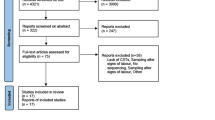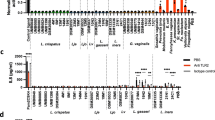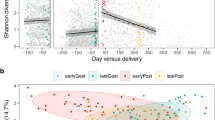Abstract
Background
To determine the association between microbial invasion of the amniotic cavity (MIAC) and the presence of Lactobacillus crispatus- or Lactobacillus iners-dominated cervical microbiota in pregnancies with preterm prelabor rupture of membrane. Next, to assess the relationship between the presence of L. crispatus- or L. iners-dominated cervical microbiota and short-term neonatal morbidity.
Method
A total of 311 women were included. Cervical samples were obtained using a Dacron polyester swab and amniotic fluid samples were obtained by transabdominal amniocentesis. Bacterial DNA, L. crispatus, and L. iners in the cervical samples were assessed by PCR. Cervical microbiota was assigned as L. crispatus- or L. iners-dominated when the relative abundance of L. crispatus or L. iners was ≥50% of the whole cervical microbiota, respectively.
Results
Women with MIAC showed a lower rate of L. crispatus-dominated cervical microbiota (21% vs. 39%; p = 0.003) than those without MIAC. Lactobacillus crispatus-dominated cervical microbiota was associated with a lower rate of early-onset sepsis (0% vs. 5%; p = 0.02).
Conclusions
The presence of L. crispatus-dominated cervical microbiota in women with preterm prelabor rupture of membrane was associated with a lower risk of intra-amniotic complications and subsequent development of early-onset sepsis of newborns.
Similar content being viewed by others
Log in or create a free account to read this content
Gain free access to this article, as well as selected content from this journal and more on nature.com
or
References
Mercer, B. M. Preterm premature rupture of the membranes. Obstet. Gynecol. 101, 178–193 (2003).
Mercer, B. M. Preterm premature rupture of the membranes: current approaches to evaluation and management. Obstet. Gynecol. Clin. North Am. 32, 411–428 (2005).
Mingione, M. J., Pressman, E. K. & Woods, J. R. Prevention of PPROM: current and future strategies. J. Matern. Fetal Neonatal Med. 19, 783–789 (2006).
Musilova, I. et al. Intraamniotic inflammation in women with preterm prelabor rupture of membranes. PLoS ONE 10, e0133929 (2015).
Cobo, T. et al. Intra-amniotic inflammation predicts microbial invasion of the amniotic cavity but not spontaneous preterm delivery in preterm prelabor membrane rupture. Acta Obstet. Gynecol. Scand. 91, 930–935 (2012).
DiGiulio, D. B. et al. Prevalence and diversity of microbes in the amniotic fluid, the fetal inflammatory response, and pregnancy outcome in women with preterm pre-labor rupture of membranes. Am. J. Reprod. Immunol. 64, 38–57 (2010).
Romero, R. et al. Sterile and microbial-associated intra-amniotic inflammation in preterm prelabor rupture of membranes. J. Matern. Fetal Neonatal Med. 28, 1394–1409 (2015).
Fortner, K. B. et al. Bacteria localization and chorion thinning among preterm premature rupture of membranes. PLoS ONE 9, e83338 (2014).
Anton, L. et al. Common cervicovaginal microbial supernatants alter cervical epithelial function: mechanisms by which Lactobacillus crispatus contributes to cervical health. Front Microbiol 9, 2181 (2018).
Rampersaud, R. et al. Inerolysin, a cholesterol-dependent cytolysin produced by Lactobacillus iners. J. Bacteriol. 193, 1034–1041 (2011).
Ravel, J. et al. Vaginal microbiome of reproductive-age women. Proc. Natl. Acad. Sci. USA 108(Suppl. 1), 4680–4687 (2011).
Romero, R. et al. The composition and stability of the vaginal microbiota of normal pregnant women is different from that of non-pregnant women. Microbiome 2, 4 (2014).
Romero, R. et al. The vaginal microbiota of pregnant women who subsequently have spontaneous preterm labor and delivery and those with a normal delivery at term. Microbiome 2, 18 (2014).
Kacerovsky, M. et al. Cervical microbiota in women with preterm prelabor rupture of membranes. PLoS ONE 10, e0126884 (2015).
Brown, R. G. et al. Vaginal dysbiosis increases risk of preterm fetal membrane rupture, neonatal sepsis and is exacerbated by erythromycin. BMC Med. 16, 9 (2018).
Dols, J. A. et al. Molecular assessment of bacterial vaginosis by Lactobacillus abundance and species diversity. BMC Infect. Dis. 16, 180 (2016).
Petrova, M. I., Reid, G., Vaneechoutte, M. & Lebeer, S. Lactobacillus iners: friend or foe? Trends Microbiol. 25, 182–191 (2017).
Kindinger, L. M. et al. The interaction between vaginal microbiota, cervical length, and vaginal progesterone treatment for preterm birth risk. Microbiome 5, 6 (2017).
Servin, A. L. Antagonistic activities of lactobacilli and bifidobacteria against microbial pathogens. FEMS Microbiol. Rev. 28, 405–440 (2004).
Ghartey, J. P. et al. Lactobacillus crispatus dominant vaginal microbiome is associated with inhibitory activity of female genital tract secretions against Escherichia coli. PLoS ONE 9, e96659 (2014).
Kusters, J. G., Reuland, E. A., Bouter, S., Koenig, P. & Dorigo-Zetsma, J. W. A multiplex real-time PCR assay for routine diagnosis of bacterial vaginosis. Eur. J. Clin. Microbiol. Infect. Dis. 34, 1779–1785 (2015).
Liu, C. M. et al. BactQuant: an enhanced broad-coverage bacterial quantitative real-time PCR assay. BMC Microbiol. 12, 56 (2012).
Fouhy, F. et al. The effects of freezing on faecal microbiota as determined using MiSeq sequencing and culture-based investigations. PLoS ONE 10, e0119355 (2015).
Kacerovsky, M. et al. Bedside assessment of amniotic fluid interleukin-6 in preterm prelabor rupture of membranes. Am. J. Obstet. Gynecol. 211, 385 e381–385 e389 (2014).
Paramel Jayaprakash, T. et al. High diversity and variability in the vaginal microbiome in women following preterm premature rupture of membranes (PPROM): a prospective cohort study. PLoS ONE 11, e0166794 (2016).
Chaemsaithong, P. et al. A rapid interleukin-6 bedside test for the identification of intra-amniotic inflammation in preterm labor with intact membranes. J. Matern. Fetal Neonatal Med. 29, 349–359 (2016).
Chaemsaithong, P. et al. A point of care test for interleukin-6 in amniotic fluid in preterm prelabor rupture of membranes: a step toward the early treatment of acute intra-amniotic inflammation/infection. J. Matern. Fetal Neonatal Med. 29, 360–367 (2016).
Ely, J. W., Rijhsinghani, A., Bowdler, N. C. & Dawson, J. D. The association between manual removal of the placenta and postpartum endometritis following vaginal delivery. Obstet. Gynecol. 86, 1002–1006 (1995).
Papile, L. A., Burstein, J., Burstein, R. & Koffler, H. Incidence and evolution of subependymal and intraventricular hemorrhage: a study of infants with birth weights less than 1,500 gm. J. Pediatr. 92, 529–534 (1978).
Yoon, B. H. et al. Microbial invasion of the amniotic cavity with Ureaplasma urealyticum is associated with a robust host response in fetal, amniotic, and maternal compartments. Am. J. Obstet. Gynecol. 179, 1254–1260 (1998).
Kacerovsky, M. et al. Amniotic fluid protein profiles of intraamniotic inflammatory response to Ureaplasma spp. and other bacteria. PLoS ONE 8, e60399 (2013).
Stray-Pedersen, B., Bruu, A. L. & Molne, K. Infertility and uterine colonization with Ureaplasma urealyticum. Acta Obstet. Gynecol. Scand. 61, 21–24 (1982).
Aaltonen, R., Heikkinen, J., Vahlberg, T., Jensen, J. S. & Alanen, A. Local inflammatory response in choriodecidua induced by Ureaplasma urealyticum. BJOG 114, 1432–1435 (2007).
Dalton, E. & Castillo, E. Post partum infections: a review for the non-OBGYN. Obstet. Med. 7, 98–102 (2014).
Furman, B., Shoham-Vardi, I., Bashiri, A., Erez, O. & Mazor, M. Clinical significance and outcome of preterm prelabor rupture of membranes: population-based study. Eur. J. Obstet. Gynecol. Reprod. Biol. 92, 209–216 (2000).
Kim, J. Y. et al. Novel antibacterial activity of beta(2)-microglobulin in human amniotic fluid. PLoS ONE 7, e47642 (2012).
Oka, K. et al. The effect of transferrin and lysozyme on antibacterial activity of amniotic fluid. Biol. Res. Pregnancy Perinatol. 8(1 1ST Half), 1–6 (1987).
Michaels, J. E. et al. Comprehensive proteomic analysis of the human amniotic fluid proteome: gestational age-dependent changes. J. Proteome Res. 6, 1277–1285 (2007).
Alcendor, D. J. Evaluation of health disparity in bacterial vaginosis and the implications for HIV-1 acquisition in African American women. Am. J. Reprod. Immunol. 76, 99–107 (2016).
Kramer, M. R. & Hogue, C. R. Place matters: variation in the black/white very preterm birth rate across U.S. metropolitan areas, 2002–2004. Public Health Rep. 123, 576–585 (2008).
Acknowledgements
This study was supported by a grant from the Ministry of Health of the Czech Republic (16-28587A).
Author information
Authors and Affiliations
Contributions
M.K., L.P., R.B., and I.M. were responsible for concept and design. M.K., L.P., R.B., R.G., P.J., P.M., O.S., T.F., J.M., P.V., H.Z., B.J., and I.M. contributed to data acquisition, analysis, and interpretation. M.K., B.J., and I.M. drafted and revised the manuscript. All authors approved the final manuscript
Corresponding author
Ethics declarations
Competing interests
The authors declare no competing interests.
Additional information
Publisher’s note Springer Nature remains neutral with regard to jurisdictional claims in published maps and institutional affiliations.
Rights and permissions
About this article
Cite this article
Kacerovsky, M., Pliskova, L., Bolehovska, R. et al. Lactobacilli-dominated cervical microbiota in women with preterm prelabor rupture of membranes. Pediatr Res 87, 952–960 (2020). https://doi.org/10.1038/s41390-019-0692-1
Received:
Revised:
Accepted:
Published:
Issue date:
DOI: https://doi.org/10.1038/s41390-019-0692-1
This article is cited by
-
Clinical characteristics of colonization of the amniotic cavity in women with preterm prelabor rupture of membranes, a retrospective study
Scientific Reports (2022)
-
Comprehensive proteomic investigation of infectious and inflammatory changes in late preterm prelabour rupture of membranes
Scientific Reports (2020)



